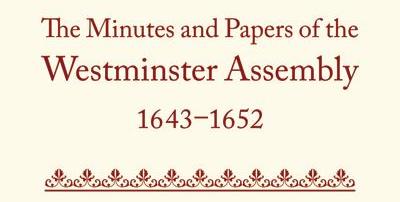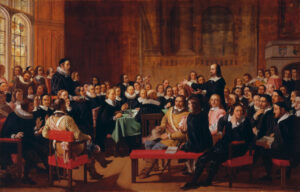The Minutes and Papers of the Westminster Assembly, 1643–1653. 5 vols. Edited by Chad B. VanDixhoorn (with David F. Wright), I: Introduction; II: Minutes, sessions 45–119, 155–198 (1643–1644); III: Minutes, sessions 199–603 (1644–1646); IV: Minutes, sessions 604–1163 (1646–1652); Assembly papers, supplementary material, and indexes. pp. xxxvii+279 incl. 7 ills; 687; 791; 897; 472. Oxford: Oxford University Press, 2012. $1155. 9780199206834
Reviewed in the Puritan Reformed Journal 12 (2020), pp.230–36.
The five-volume edition of the Minutes and Papers of the Westminster Assembly has established itself as one of the most important scholarly works for the study of English post-Reformation historical-theology and early modern English religious history. It makes a unique and incalculable contribution to understanding not only the Assembly and its principle documents, but to the historical, ecclesiastical, and political context of the interregnum. Although Chad Van Dixhoorn undoubtedly receive significant guidance along the way from numerous assistants and especially from David F. Wright and John Morrill, the exacting level of detail and virtually flawless final product of over one million words was the result of Chad Van Dixhoorn’s twelve years of full-time arduous labor. These volumes will be of tremendous benefit to confessional ecclesiastical historians and scholars of early modern England. A debt of gratitude is owed to not only Dr. Van Dixhoorn, but to his wife and children for their sacrifice.
As John Morrill explains in his forward to the volumes, prior to the publication of the MPWA, there were essentially two historiographical camps who explored the events and details of the Westminster Assembly. One the one hand was “horizontal tradition” of seventeenth-century historians of the English Civil War, who primarily depicted the Assembly as a body of theologians, whose ideologies drove the revolution. One the other hand was a “vertical tradition” of historians who viewed themselves as part of the living tradition of the ministers and confessions they studied. Often times subscribers to the Standards have studied them in a manner disembodied from their political and ecclesiastical context. For that reason, it has been often overlooked, or greatly underappreciated, that The Westminster Assembly took place at an important time in English and Protestant history, namely, in the context of the English Civil War. However, a reading of the MPWA reveals that understanding the historical and political context sheds light on the motivations and goals of the Assembly members.
These volumes not only fill in the gaps in the historical record to provide a definitive account of the enduring records of the Assembly. While the three massive folio volumes housing Doctor Williams Library are the principle sources for the MPWA, personal diaries, public newspapers, and other documents supplement these volumes to provide a full-orbed record of this event. There was tremendous paleographical labor involved in transcribing these documents, especially transcribing the atrocious hand of the Assembly’s scribe, Adoniram Byfeld, who had, in John Morrill’s estimation “the worst handwriting I have yet encountered from the seventeenth century” (i, p. ix). For this labor, the scholarly community will remain forever grateful.
Volume 1 provides a clear and concise introduction to background, workings, and practical details of the Assembly. It reveals that in order to understand the MPWA, one must recognize that they are crafting after a decade of reform under Archbishop William Laud and the members of the infamous Durham House group, who not only persecuted members of the Puritan movement and Westminster Assembly, but sought to impose the “beauty of holiness” movement on the English Church. This, of course, lead to the Scottish revolution following William Laud’s attempts at reform in Scotland by imposing the revised prayer book on its people in 1637. Eventually the Scots rebelled, and English Presbyterians joined them, leading to open revolt in the northern kingdom that spread to Ireland and forced Charles to raise an army to fight the Scots. The king survived for a time, but in 1641 Archbishop Laud was arrested and put on trial. Since this was a time in which political stability and ecclesiastical reform were seen as in separately linked, as Parliament—which contained a number of influential Puritans—gained political power, they pursued a Reformation of religion.
The seeds of what would eventually become the Westminster Assembly were planted in 1641 with petitions for “a free synod to Reform the Reformation itself” that would not only reverse Laudian reform, but establish a purity of worship, polity, and doctrine. Parliament also crafted the Solemn League and Covenant (1643)—a contract created by Parliament between them and the Scottish rebels stating that they supported the Scots in their rebellion over the prayer book. Although Parliament wanted the King’s consent, Charles’s condemned the Westminster Assembly and Solemn League and Covenant as being treasonous against the King. Charles I was eventually captured by the New Model Army (led by Oliver Cromwell), tried, and eventually executed January 30, 1649.
On June 12, 1643, Parliament released a summoning ordinance to gather together “an Assemblie of Learned and Godlie divines” “for the Settling of the Government and the Litturgie of the Church of England.” The introduction explains how the Assembly members were chosen by Parliament and advisory board made up of clergymen. The support of major puritan leaders and the existence personal relationships between invited members and the selection committee were the primary factors in determining who was invited to the Assembly. The total number of invited participants was 120, although the average attendance of most sessions was between seventy to eighty members. Also, the terminological parallels between the Westminster Assembly summons and the Solemn League and Covenant reveals that attendance at the Westminster Assembly was the definitive litmus test for Calvinist clergy regarding their political allegiance. Although initially there was some desire for international participation in the Assembly, like with the Synod of Dort, this never came to fruition. Eventually, the Assembly eventually convened on July 1, 1643 to redefine and refine Orthodoxy in England following a tumultuous decade of Laudian reform. This body was the intellection engine behind Parliament and the Puritan revolution and became one a the most formidable institutions of the three Kingdoms, not only throughout the Interregnum, but the whole the early modern period.
Volume 1 gives us a window into the physical and spiritual challenges they faced. The assembly met extensively over a decade of turmoil—1330 times from 1643-1652 and then appeared to meet for another year, likely on a weekly basis. We learn that the Assembly met Monday through Friday, their days began at 6:00am with a lecture and prayer, followed by a sermon from a probationary minister, and then committee meetings. The plenary sessions began at 9am and consisted of debating the day’s proposition until lunch (usually breaking between noon and 2pm). Following lunch were further committee meetings until around 5:00pm or later. In all, “approximately 2400 people appearing in 11,300 separate occurrences are mentioned in the minutes of the assembly” (i. 91).
While their initial aims were to reform the Thirty-nine Articles, eventually, they pursued a full-scale reformation of English worship, doctrine, and church government. Yet, these were not their only topics of discussion. As VanDixhoorn explains, there were many topics of debate and discussion: “The divines could spend a day discussing whether a man’s pastoral gifts would rust if he took an academic appointment, but they could also debate the geography of Palestine, the distance that sound travelled in dry and humid environments, the possibility of an oral tradition or an Ur-text behind the four gospels, and Christian practices in Russia, India, and the new world” (i, p. xiv). Here we discover, as John Morrill says, “men struggling to maintain focus and to translate the lessons of scripture into actions and structures for their age and for the time to come.” They reveal that these were “men under intolerable strain and striving to keep unity in the face of innumerable pressures, internal and external, temporal and geopolitical, personal and collective” (i, p. ix). They allow us to appreciate the literal blood, sweat, and tears that went into crafting these principal documents. This reveals that far from being armchair theologians, these men understood that the matters they were considering were truly a matter of life and death. They pursued their ministry in the midst of a gruesome Civil War that divided the country and resulted in the only execution of an English King in history. As a result of these labors, they produced the following principal documents—the Westminster Confession of Faith, the Westminster Larger Catechism, the Westminster Short Catechism, the Directory of Worship, a Psalter, a lengthy treatise of the Assembly, and a series of papers exchanged by the minority and the majority. The MPWA also reveal that they examined over 2000 preachers, and some heretics, which undoubtedly has laid the groundwork for a number of excellent studies. Undoubtedly, they will be an invaluable resource to understanding the various minor and major views of the Assembly members as they crafted these confessional doctrinal documents.
This volume provides details of the definitive movements in the Assembly, such as, for example, how English divines rejoiced in the Scottish commissioners’ arrival on September 15, 1643 and that this event resulted in a shift of focus on the issues of church government, which captured an astonishing one fourth of all the Assembly’s plenary sessions. We also receive further insight into the English Congregationalists’ participation in the Assembly before their departure in 1644, learning that members of the Assembly were actually quite embarrassed by the fact that Parliament had significant control over the assembly. Parliament set the Assembly’s agenda, and thirty members of parliament—20 members of the Commons, 10 members of the Lords—were actually part of the assembly, though they were not always present. In fact, in letters to their foreign contemporaries, assembly members did not mention that the assembly was summoned by parliament and that lay MPs attended (and oversaw) their meetings.
It uncovers the reality that there were many practical matters involved in members’ attending the assembly, including a number of the men moving with their families to London to participate. This explains why only half of those invited were present at the opening ceremony. They also divulge many practical details that surround the Assembly meetings, like the ground rules established by the Assembly for debate and that members were paid 4s. per day for their labors, though, in the end, members only received half of the final renumeration that was due to them. They also provide a window into other facets of the mid-seventeenth-century context, including, “censorship, prison conditions, marriage practices, the power of monopolies, and the creation of an Oxford college in London.” (i, p. xiv). MPWA will allow further studies on the 1640s, specific Assembly members, and “comparative studies in synodical practice, creedal formulation, and doctrinal development among Protestants.” (i, p. xv). Finally, volume 1 the MPWA also contains seventeen enlightening appendices. Among these are a biographical dictionary, which provides a helpful summary of all those invited to the Assembly, and an analysis of the twelve theologians, who were the chief contributors to the Assembly debates, referenced in just over fifty percent of the Minutes.
Volumes two through four contain the minutes themselves of the plenary sessions. One particularly helpful feature of these volumes is that each plenary session begins with a detailed summary headnote, which gives an overview of the various speeches and debates of that particular session. Indeed, one would gain a clear awareness of the basic proceedings of each plenary session simply by reading these summary heads. The minutes themselves are brief summaries of the speeches, dialogue, and debates given by Assembly members, and for the first time, we can engage with all of the survive votes and debates that took place in the Assembly. In short, the minutes give us an unparallel window into the assembly’s speeches, dialogues, and debates. They reveal that far from being a uniform body, there was a divergence of views on even seemingly essential theological issues and that members were “constantly shifting allegiances depending on the issue at stake” (i. 31). Grasping the context or intended meaning of these speeches and debates is only done so through an ongoing engagement with the minutes themselves. Indeed, they repay giving careful, often painstaking, attention to detail and engagement with each plenary session in the context of the whole. Furthermore, the exceptionally helpful footnotes that contain either textual and bibliographical notes on these speeches aid the reader not only in understanding the plenary sessions but are invaluable for further study of these speeches and the members themselves. Finally, Volume V contains another 141 assembly papers and a series of helpful indexes.
It’s important to underscore that the MPWA are not self-explanatory. In this way, the MPWA provide an apologetic for study theology in its historical context for understanding the English Civil War and the other ecclesiastical political events of the 1640s are vital to understanding not only the Assembly itself, but especially the confessions, catechisms, and other documents that arose out of the Assembly. VanDixhoorn counsels that the MPWA should “be read with a Bible in one hand and the journals of the House of Lords and House of Commons in the other. These texts are the indispensable tools for understanding the assembly” (i. 95). It is helpful to know that in the next couple of years there will be another resource that will be invaluable to have as you engage with the minutes, namely, Chad Van Dixhoorn’s long awaited published dissertation, which is currently due to be published with Oxford University Press in 2021.
Although analyzing and understanding the MPWA in their historical context may appear to be an exercise for only professional historians, the MPWA reveal that this is actually imperative for a full and robust interpretation, exposition, and application of those confessional, catechetical, and other ecclesiastical documents that arose from the Westminster Assembly. Indeed, without understanding the Assembly’s context, these confessional documents are easily misinterpreted, and the richest of components of these confessional formulizations are certainly bypassed. They are a testimony to the reality that Church history is part of theological discourse (and vice versa) and therefore to study theology in its historical context is to study it on its own terms (i.e. in its historical context). To deny this is , at best, to pursue a thin understanding of the Assembly and its document and, at worst, to teleologically project one’s own preconceived conclusions and modernistic categories on the Assembly, as previous generations of historians and theologians of the Assembly have been guilty of pursing. Thus, for those studying historical theology or even ministering in confessional Presbyterians denominations, the MPWA are an invaluable resource.
Greg A. Salazar
Assistant Professor of Historical Theology
Puritan Reformed Theological Seminary




